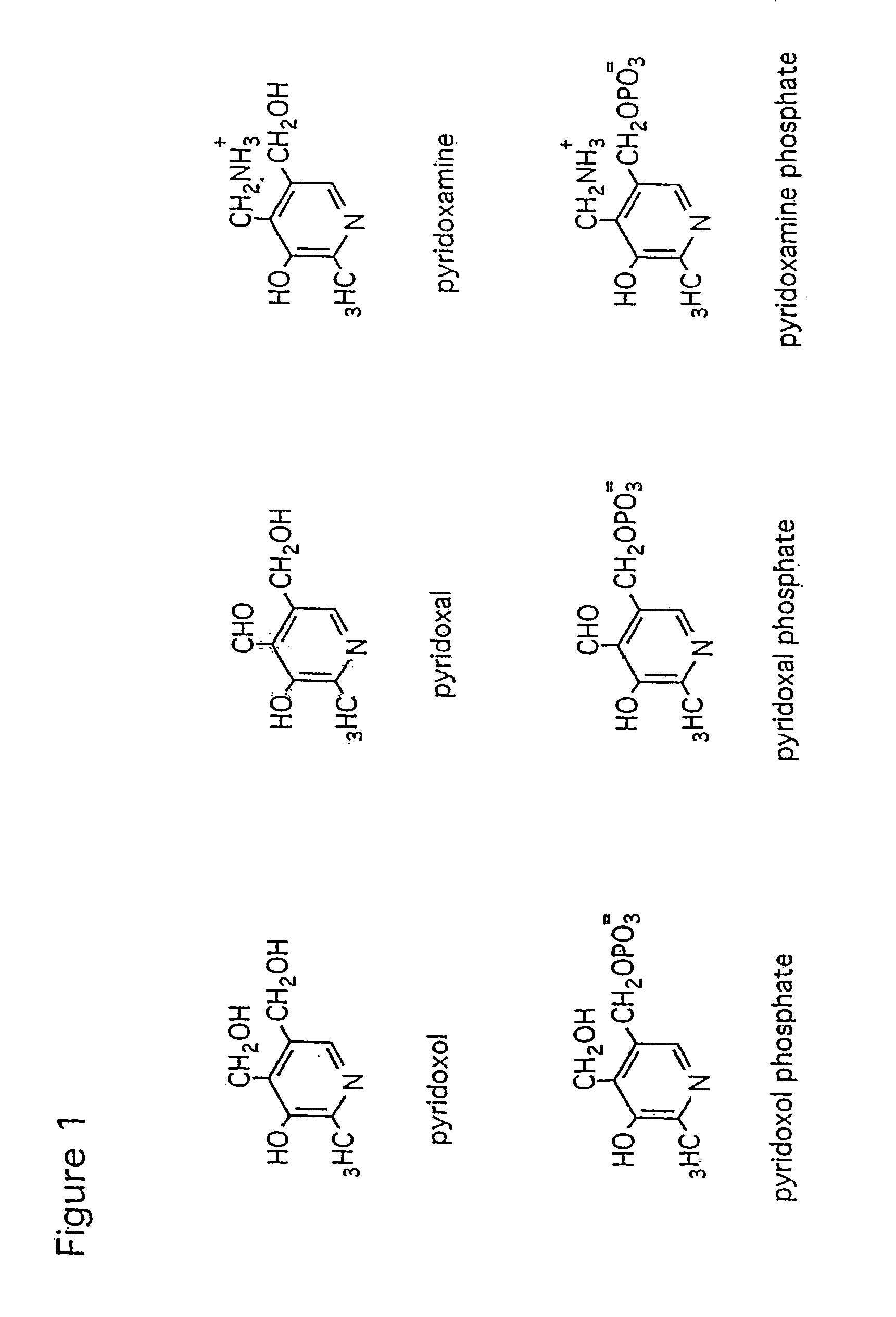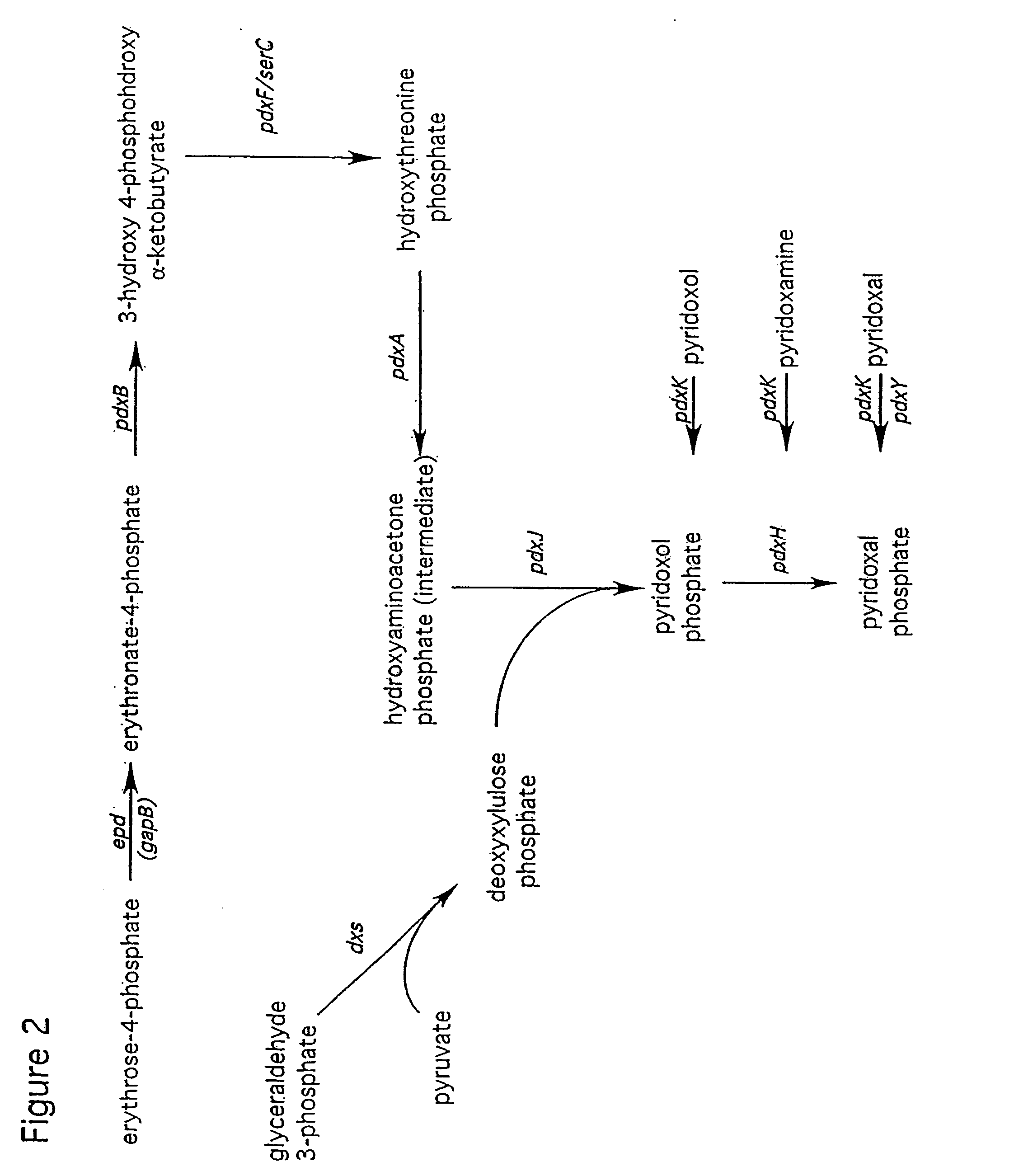Methods and organisms for production of b6 vitamers
a technology of vitamers and organisms, applied in the field of methods and organisms for producing b6 vitamers, can solve the problems of insufficient sequence homology of protein or dna sequences to establish biological functions, inability to identify plp biosynthesis precursors in i>s. cerevisiae /i>, and insufficient sequence homology of plp genes and genes in any given organism, etc., to achieve the effect of increasing the level of one or more enzym
- Summary
- Abstract
- Description
- Claims
- Application Information
AI Technical Summary
Benefits of technology
Problems solved by technology
Method used
Image
Examples
example 1
Biological Assay for B6 Vitamers Using Saccharomyces uvarum
[0088] Quantitation of B6 vitamers in supernatants of cultures of micro-organisms or extracts of organisms that have been genetically modified to increase production of B6 vitamers is conveniently done using Saccharomyces uvarum (formerly and still often named S. carlsbergensis) strain ATCC 9080 as the indicator strain or test organism. The method is essentially that described in the Difco Manual (1984, Difco Laboratories, Detroit, Mich., 10th Edition, pp. 1104-1106), with the modification that 50 mg / liter of streptomycin sulfate is added to the liquid growth medium for the test organism. However, any other appropriate indicator organism may be used, together with a medium that is appropriate for that organism that is free of B6 vitamers. For example, an E. coli pdxB mutant can be used in a standard minimal medium that is well known in the art, such as M9 glucose minimal medium (Miller, J., (1972) Experiments in Molecular G...
example 2
Deletion of a Portion of the yaaDE Operon in B. subtilis.
[0090] The SOR and SNO genes of Cercospora nicotianae were originally identified by mutations that lead to hypersensitivity to singlet oxygen-generating reagents (Ehrenschaft, M., et al. (1999) Proc. Natl. Acad. Sci. USA 96: 9347-9378). Mutations in either of these genes also lead to PL auxotrophy. The protein sequences obtained from translation of the SOR and SNO open reading frames were used as homology probes to search through the B. subtilis genome sequence using the BLAST homology search program of the Subtilist website. The SOR protein was significantly homologous to the YaaD protein, and the SNO protein was significantly homologous to the YaaE protein. Moreover, the genes encoding the YaaD and YaaE proteins (namely yaaD and yaaE) occur adjacent to each other on the B. subtilis chromosome as a two gene operon.
[0091] General methods for growth, storage, transformation, and molecular biology of B. subtilis strains are gi...
example 3
Deletion of yhaF in B. subtilis.
[0093] The protein sequence of the E. coli pdxF gene was used as a probe to search the B. subtilis genome as described in Example 1. The only significant homolog was yhaF. In a fashion similar to that of Example 1, the yhaF was cloned and deleted from the chromosome of PY79 using plasmid pDX11F (SEQ ID NO:6, FIG. 5), to give strain PX11. The PCR primers used to clone yhaF were RY407 (SEQ ID NO:3) and RY408 (SEQ ID NO:4). The restriction sites used for insertion of the antibiotic resistance gene were the PshA1 and EheI sites in the yhaF coding region. PX11 is a serine auxotroph, but not a PL auxotroph. By comparison to E. coli, it appears that yhaF functions in serine synthesis and probably encodes the equivalent of SerC, but that the YhaF protein is not required for PLP synthesis in B. subtilis. Therefore, it is established that sequence homology alone does not necessarily imply functional homology.
PUM
| Property | Measurement | Unit |
|---|---|---|
| concentration | aaaaa | aaaaa |
| temperatures | aaaaa | aaaaa |
| temperatures | aaaaa | aaaaa |
Abstract
Description
Claims
Application Information
 Login to View More
Login to View More - R&D
- Intellectual Property
- Life Sciences
- Materials
- Tech Scout
- Unparalleled Data Quality
- Higher Quality Content
- 60% Fewer Hallucinations
Browse by: Latest US Patents, China's latest patents, Technical Efficacy Thesaurus, Application Domain, Technology Topic, Popular Technical Reports.
© 2025 PatSnap. All rights reserved.Legal|Privacy policy|Modern Slavery Act Transparency Statement|Sitemap|About US| Contact US: help@patsnap.com



